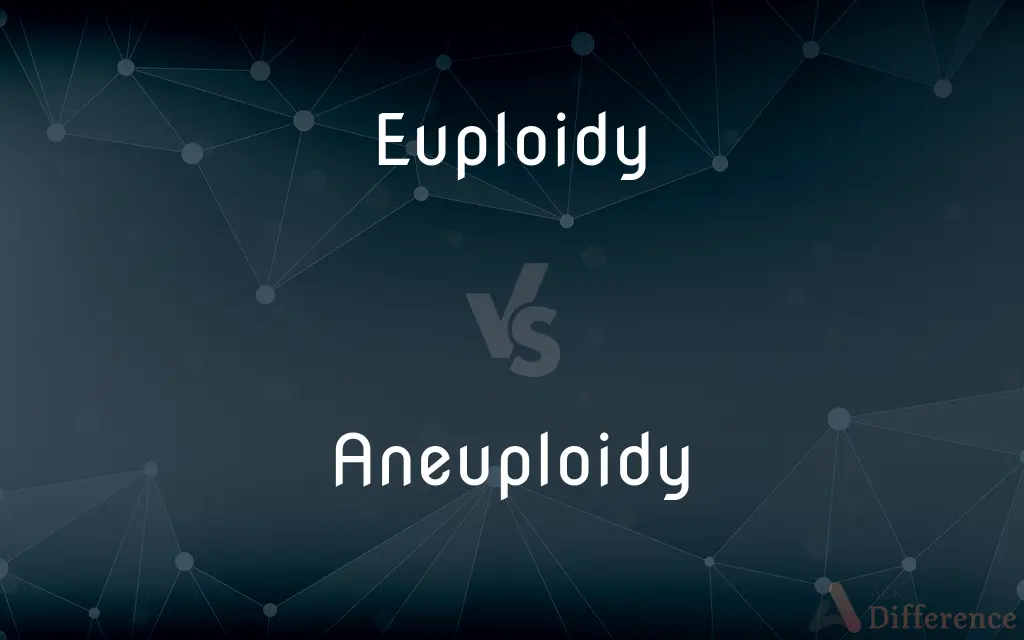Euploidy vs. Aneuploidy — What's the Difference?
By Urooj Arif & Fiza Rafique — Updated on March 16, 2024
Euploidy is a chromosome number variation involving whole sets of chromosomes, leading to organisms with multiples of the normal set. Aneuploidy involves the addition or deletion of individual chromosomes, disrupting the normal chromosome number.

Difference Between Euploidy and Aneuploidy
Table of Contents
ADVERTISEMENT
Key Differences
Euploidy refers to a condition where organisms have a chromosome number that is an exact multiple of the haploid number, leading to polyploidy when there are more than two sets of chromosomes. This can result in organisms that are triploid, tetraploid, or even higher, often enhancing genetic diversity and vigor. On the other hand, aneuploidy is characterized by the presence of an abnormal number of chromosomes, either through the loss or gain of one or more chromosomes but not entire sets, which can cause genetic disorders and developmental issues.
In plants, euploidy often results in beneficial variations, contributing to species diversity and adaptability. Many agriculturally important plants are polyploids, showing improved traits such as larger fruit size and better disease resistance. Whereas, aneuploidy in plants can lead to abnormal growth patterns and reduced fertility, but it can also contribute to diversity and adaptation in some cases.
In humans and other animals, euploidy is less common and usually not viable beyond the diploid stage, with notable exceptions like certain polyploid fish and amphibians. Aneuploidy in humans, however, is a common cause of genetic disorders such as Down syndrome (trisomy 21), Turner syndrome (monosomy X), and Klinefelter syndrome (XXY), impacting health and development significantly.
The formation of euploid organisms typically occurs through errors in cell division processes such as meiosis or mitosis, leading to the doubling of the chromosome set. This can happen naturally or be induced artificially in plants for agricultural benefits. In contrast, aneuploidy usually arises from nondisjunction events during meiosis or mitosis, where chromosomes do not separate properly, leading to gametes or cells with abnormal chromosome numbers.
Conservation and study of euploid variations are crucial in agriculture and horticulture for breeding programs aimed at improving crop species. Aneuploidy, while often associated with negative effects in humans, provides valuable insight into chromosome function, genetic disorders, and the evolutionary process, highlighting the delicate balance of chromosome number in organism development and health.
ADVERTISEMENT
Comparison Chart
Definition
Organisms have chromosome numbers that are whole multiples of the haploid set.
Organisms have an abnormal number of chromosomes, not whole sets.
Common in
Plants, some fish and amphibians.
All eukaryotes, including humans.
Examples
Wheat (hexaploid), Strawberries (octoploid).
Down syndrome (trisomy 21), Klinefelter syndrome (XXY).
Causes
Errors in cell division leading to doubling of chromosome sets.
Nondisjunction during meiosis or mitosis leading to abnormal chromosome numbers.
Impact on Organisms
Often beneficial in plants, leading to increased vigor and diversity. Rare and usually not viable in animals.
Often detrimental, leading to genetic disorders and developmental issues. Can contribute to diversity and adaptation.
Agricultural relevance
Used in breeding programs to improve crops.
Less commonly utilized, but important for genetic studies and understanding plant diversity.
Compare with Definitions
Euploidy
Euploidy is the presence of complete chromosome sets in an organism.
Many commercial bananas are triploid, with three sets of chromosomes.
Aneuploidy
It can result from errors in chromosome separation during cell division.
Turner syndrome results from a missing X chromosome in females.
Euploidy
It often results in polyploidy, leading to genetic diversity and robustness.
Tetraploid cotton varieties exhibit improved fiber quality.
Aneuploidy
Aneuploidy refers to an abnormal chromosome number not involving entire sets.
Down syndrome is caused by an extra chromosome 21.
Euploidy
Euploidy plays a significant role in agriculture and horticulture.
Polyploid crops can show increased yield and hardiness.
Aneuploidy
Aneuploidy is often associated with genetic disorders and developmental issues.
Individuals with Klinefelter syndrome (XXY) can have fertility problems.
Euploidy
Euploidy can enhance certain traits like size and disease resistance in plants.
Seedless watermelons are often triploid.
Aneuploidy
In plants, aneuploidy can lead to abnormal growth but also genetic diversity.
Some aneuploid plants may show unusual flower colors.
Euploidy
In animals, euploidy beyond the diploid state is rare and usually not viable.
Most animal species are strictly diploid.
Aneuploidy
The study of aneuploidy helps understand chromosome function and genetic diseases.
Research on aneuploidy has advanced our knowledge of genetics and evolution.
Euploidy
Having a chromosome number that is an exact multiple of the haploid number for the species.
Aneuploidy
Aneuploidy is the presence of an abnormal number of chromosomes in a cell, for example a human cell having 45 or 47 chromosomes instead of the usual 46. It does not include a difference of one or more complete sets of chromosomes.
Euploidy
A euploid organism or cell.
Aneuploidy
Having a chromosome number that is not a multiple of the haploid number for the species.
Euploidy
(genetics) The condition of having a chromosome number that is an exact multiple of the haploid number for the species.
Aneuploidy
An aneuploid organism or cell.
Aneuploidy
(genetics) The condition of being aneuploid; the state of possessing a chromosome number that is not an exact multiple of the haploid number of the organism in question.
Aneuploidy
An abnormality involving a chromosome number that is not an exact multiple of the haploid number (one chromosome set is incomplete)
Common Curiosities
How does euploidy differ from aneuploidy?
Euploidy involves whole sets of chromosomes being added or multiplied, while aneuploidy involves the addition or loss of individual chromosomes.
What is aneuploidy?
Aneuploidy occurs when an organism has an abnormal number of chromosomes, either more or less, but not in complete sets.
Why is aneuploidy often harmful?
Aneuploidy disrupts the normal balance of genes, leading to developmental problems and genetic disorders.
What is euploidy?
Euploidy is when an organism's cells contain complete sets of chromosomes, in multiples of the haploid number.
Can euploidy be beneficial?
Yes, especially in plants, euploidy can result in beneficial traits such as increased size and disease resistance.
Is euploidy common in animals?
No, euploidy beyond the diploid state is rare and usually not viable in animals.
What causes aneuploidy?
Aneuploidy is typically caused by nondisjunction, where chromosomes do not separate properly during cell division.
How is euploidy used in agriculture?
Euploidy, particularly polyploidy, is exploited in agriculture to breed crops with desirable traits.
What are some disorders associated with aneuploidy?
Disorders such as Down syndrome, Turner syndrome, and Klinefelter syndrome are associated with aneuploidy.
What causes euploidy?
Euploidy can occur due to errors in cell division processes, leading to the doubling or multiplication of chromosome sets.
Is polyploidy the same as euploidy?
Polyploidy is a form of euploidy where there are more than two sets of chromosomes in an organism.
Can aneuploidy occur in plants?
Yes, aneuploidy can occur in plants, sometimes leading to unique traits or reduced fertility.
How is aneuploidy detected?
Aneuploidy can be detected through genetic testing methods like karyotyping, FISH, and comparative genomic hybridization.
Can euploidy be artificially induced?
Yes, in plants, euploidy can be artificially induced through chemical treatments to create polyploid organisms.
What evolutionary significance does aneuploidy have?
Aneuploidy can contribute to genetic diversity and evolution, despite its potential negative effects on individuals.
Share Your Discovery

Previous Comparison
Incident vs. Disaster
Next Comparison
Cupboard vs. PressAuthor Spotlight
Written by
Urooj ArifUrooj is a skilled content writer at Ask Difference, known for her exceptional ability to simplify complex topics into engaging and informative content. With a passion for research and a flair for clear, concise writing, she consistently delivers articles that resonate with our diverse audience.
Co-written by
Fiza RafiqueFiza Rafique is a skilled content writer at AskDifference.com, where she meticulously refines and enhances written pieces. Drawing from her vast editorial expertise, Fiza ensures clarity, accuracy, and precision in every article. Passionate about language, she continually seeks to elevate the quality of content for readers worldwide.














































